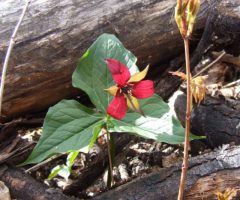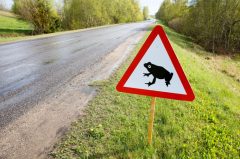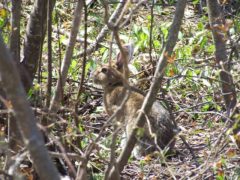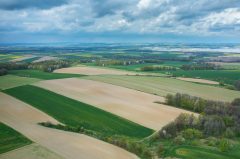By Kristy Strauss
When Lenore Fahrig would go visit her parents in Merrickville, Ontario – about an hour drive outside Ottawa – she noticed something strange.
As she drove the usual route along the Rideau River on the bustling Old Highway 16, and then on the quiet County Road 2, she noticed there seemed to be more dead frogs and toads on the less-traveled road.
“There was a lot more traffic on 16, so you might expect there to be more dead frogs and toads there,” explains Dr. Fahrig, a professor in Carleton’s Department of Biology. “This got me wondering whether there are fewer dead frogs and toads on 16 because, after many years of road-kill, the population sizes of frogs and toads along Highway 16 have been reduced. I thought maybe there just aren’t nearly as many frogs and toads there anymore, because so many of them have been killed.”
Fahrig set out to test her hypothesis, and published a paper about it in 1995 entitled Effect of Road Traffic on Amphibian Density. The paper grabbed the attention of a couple students, who wanted to study the subject as part of their graduate work.
This marked the beginning of two decades of Fahrig’s in-depth research program dedicated to the effects of roads on wildlife – from mammals of all sizes to frogs and toads, turtles, and even insects.
In her Geomatics and Landscape Ecology Laboratory at Carleton, she has also expanded her research and made surprising conclusions about the size of crop land, and its effect on biodiversity.
Roadways and their impacts on animals
As part of her research, Fahrig has looked at how fencing lowers amphibians and reptiles’ mortality rate rather than culverts – which is a tunnel that is constructed under a road.
In her paper entitled Culverts alone do not reduce road mortality in anurans, Fahrig and her colleagues found that culverts don’t work well for a couple of reasons.
“The main one is that frogs don’t realize the culverts are there. If a frog encounters a road, it apparently doesn’t think to itself, ‘Hey, I wonder if there’s a culvert nearby that I could use to cross the road safely,’” she explains. “It just tries to cross over the road in the spot where it encounters it, and often gets killed there. The second reason is that culverts are a lot different from the natural environment, so frogs are probably not much inclined to go into them. They don’t ‘know’ that the culvert leads to the other side of the road.”
Fahrig says that frogs have to be led to a culvert by fencing off the road, so their only option is to cross the road through the culvert. She adds that frogs can also be kept off the road by raising the road about one metre, and putting concrete on the roadbed’s sides.
Fahrig says that this paper is relevant to Canada in particular, where it snows more often.
 “Snow removal and the snow itself can do a lot of damage to fencing,” she says. “This means that fencing has to be constantly maintained and even rebuilt, which is a big investment. So, any way to reduce frog mortality on roads, without installing fences, would be very useful in Canada.”
“Snow removal and the snow itself can do a lot of damage to fencing,” she says. “This means that fencing has to be constantly maintained and even rebuilt, which is a big investment. So, any way to reduce frog mortality on roads, without installing fences, would be very useful in Canada.”
Keeping this in mind, Fahrig would like to look at the idea of whether extended stream crossings could be a partial solution for frogs.
These extended stream crossings would replace culverts under roads, explains Fahrig, and animals could follow those crossings instead of the road – and eliminate the need for fencing.
In a study entitled Influence of traffic mortality on forest bird abundance, she and her colleagues also looked at how road kill has an effect on bird populations near high-traffic roads.
Since studies have shown that the number of birds are reduced within 250 metres of high-traffic roads, researchers in the past have concluded that these reduced numbers are because of traffic noise.
“They argue that, because birds communicate with each other by singing, traffic noise interrupts their ability to communicate,” says Fahrig. “If birds can’t hear each other, they can’t attract mates, maintain territories, or communicate with their young. All of this might cause problems for reproduction and survival. At least, that is the argument.”
However, her study found that bird populations are reduced near high-traffic roads because of more than traffic noise – it’s also road kill that plays a major role.
The study showed that bird numbers are lower near high-traffic roads because many of them are killed on the roads.
“I think the design of the study was quite ingenious,” says Fahrig. “It took advantage of the fact that forest birds cross small gaps in forest. That means that, if road kill has a big effect on birds, we should see that effect along roads that cut a path through the forest, and not so much along roads where there is forest on one side and an open field on the other side. This is exactly what we found in this study.”
 She adds that this new finding is important because now researchers can look at how the road, and traffic, make an impact – and can find ways to reduce that impact.
She adds that this new finding is important because now researchers can look at how the road, and traffic, make an impact – and can find ways to reduce that impact.
While people might be used to seeing road kill, Fahrig says her research digs deep into its effect on wildlife populations.
Additionally, she says the importance of fencing may be surprising to some.
“Our research shows that the most important thing is not that the animal gets across the road, but that it doesn’t get killed on the road,” she says. “In other words, it would usually be better to fence the whole road and keep the animals off it so they don’t get killed, than to leave it unfenced so that a few animals can get across (but others are killed).”
Crop fields and biodiversity
Over the years, Fahrig’s lab has also expanded to study the size of crop land, and its effect on biodiversity.
 In the paper entitled Farmlands with smaller crop fields have higher within-field biodiversity, Fahrig and her colleagues found that a large number of small crop fields in farmland had higher biodiversity. Farmland that had only a couple of very large crop fields had less biodiversity.
In the paper entitled Farmlands with smaller crop fields have higher within-field biodiversity, Fahrig and her colleagues found that a large number of small crop fields in farmland had higher biodiversity. Farmland that had only a couple of very large crop fields had less biodiversity.
“This is really important because the trend, worldwide, is to enlarge crop fields,” she says. “This is moving in the wrong direction for biodiversity. For a given amount of cropped area, there is less damage to biodiversity if we divide the cropped area into small crop fields than if we have a few large crop fields.”
Fahrig thinks that farmlands with small crop fields are better for biodiversity because they have many field edges – which are important for preserving biodiversity, because it offers a good habitat between fields that are maintained by farmers.
“The field edges represent small ‘refuges’ where wildlife can escape to when conditions in the field are not good,” she says. “Access to these refuges is much higher in farmlands where there are lots of small fields than in farmlands where there are only one or two big fields.”
Fahrig adds that the most surprising part of her research is that she and her colleagues consistently found that farmland with small crop fields are better for biodiversity in birds, plants, butterflies, bees, beetles, flies and spiders.
She also thinks people might be most surprised by the fact that biodiversity can be improved without taking farmland out of food production.
“Our research shows that you can maintain the same area of productive farmland, but if you divide it into smaller fields, the biodiversity there will be higher,” Fahrig says.
Looking ahead
Loss of biodiversity has become a major global issue, she says, adding that many see the current crisis as a mass extinction – very much like mass extinctions millions of years ago.
However, this time around, it is caused by humans.
“The biggest reason for the current biodiversity crisis is conversion of natural lands to farmlands,” Fahrig says. “Another important reason is the impact of roads and traffic on wildlife, and this impact is increasing as the road network expands and traffic volumes climb.”
She adds that her lab’s research is vital to understanding why the number of species is declining, so that this issue can be solved.
“I hope people will translate the results into action to limit biodiversity losses,” Fahrig says.